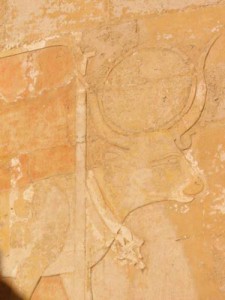God of the sky, the sun, the queen, music, dance and the arts.
Appearance of a cow bearing the sun disk between her horns, or a woman in queenly raiment wearing the sun disk and horns on her head. Depictions of her as a woman with a cow’s head do not occur until later periods.
 Hathor is a very ancient goddess, dating to predynastic times. When dynastic rule began, as Horus was associated with the king, Hathor was with the queen. Her name translates to “The House of Horus,” and so she is associated with the royal family. But also, as the entire world could be said to be the House of Horus, Hathor can be seen as the mother-goddess of the whole world, similar to Isis.
Hathor is a very ancient goddess, dating to predynastic times. When dynastic rule began, as Horus was associated with the king, Hathor was with the queen. Her name translates to “The House of Horus,” and so she is associated with the royal family. But also, as the entire world could be said to be the House of Horus, Hathor can be seen as the mother-goddess of the whole world, similar to Isis.
Hathor’s cult is unusual, as both men and women were her priests (most deities had clerics of the same gender as they). Many of them were artisans, musicians, and dancers who turned their talents into creating rituals that were nothing short of works of art. Music and dance were part of the worship of Hathor like no other deity in Egypt. Hathor herself was the incarnation of dance, and stories were told of how Hathor danced before Ra when he was in despair to cheer him up. Inspiration was also Hathor’s bailiwick, and many would come to the temples of Hathor to have their dreams explained or to beseech her for her aid in creation, much in the same way the Greeks invoked the Nine Muses.
Worshipped throughout all of Egypt, her cult center was at Dendera in Upper Egypt.